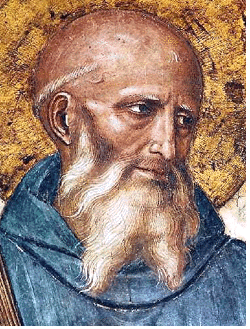...Best of Sicily presents... Best of Sicily Magazine. ... Dedicated to Sicilian art, culture, history, people, places and all things Sicilian. |
by Vincenzo Salerno | ||
Magazine Index Best of Sicily Arts & Culture Fashion Food & Wine History & Society About Us Travel Faqs Contact Map of Sicily |
The Benedictines are usually considered the first "Western" (Roman Catholic) religious order, and in Sicily their greatest lasting monuments are Monreale Abbey and (in Palermo), the little monastery of Saint John of the Hermits. The founder of the order was Saint Benedict of Nursia (now Norcia), in Umbria, born around 480. Benedict died in 543. By the eleventh century his order had become a powerful force in the Catholic Church across western Europe. Born into a Roman noble family during the waning years of the Empire, Benedict left Rome by about the age of twenty to seek a quiet life outside the city, though not necessarily as a hermit. Others eventually joined him in this quest. Monasteries already existed in central Italy, but Benedict's community was better organised and followed a defined Rule. Under Benedict as abbot, a number of monasteries were founded, including (around 529) Monte Cassino, the largest. Benedict is also credited with establishing several monastic schools for children, not as seminaries but as places where young boys and girls from all social classes could learn. One aspect of Saint Benedict's life has long been a matter of arcane if lively scholarly debate. Did he actually intend to found a new religious order, or simply establish a few monasteries? In other words, was the order itself founded by him, or was it formally founded long after his death? The continuity of Benedict's community as a defined religious institution cannot be dated reliably until at least several centuries after his death, whereas the Franciscans, for example, can trace their history as an actual order to the lifetime of their founder. (Saint Francis eventually rebelled against "his" order having become too complicated and worldly for his own taste, and we cannot know whether Benedict --who the Orthodox consider one of their own-- would have recognised in the "westernised" twelfth century Benedictines the community he established long before the Schism.) In the event, his Rule was initially intended for laymen rather than clerics. Whatever the evolution of the community, Montecassino certainly continued to be an important center of learning and monastic life from Benedict's time onward. Unlike other religious orders, the Benedictines have a collegial structure. Monasteries do not answer to a rigid hierarchy such as those of the Dominicans (founded in 1206) and Jesuits (founded in 1534). In this sense, the Benedictines have something in common with their Orthodox brothers. Several other orders grew from the Benedictine tradition, most notably the Cistercians (founded in 1098), who were introduced in Sicily during the later years of Norman rule. In Sicily and Calabria the Benedictines were supplanted by newer orders toward the end of the Middle Ages. The Dominicans (often associated with the Inquisition) were the largest of these. Monte Cassino still exists, having survived destructive bombing during the Second World War, and some Benedictine institutions are so revered as to seem almost legendary (among schools England's Ampleforth comes to mind). In southern Europe and the United States the Jesuits have, to some degree, taken the place of the Benedictines as educators. With the exception of the Franciscans (founded in 1209), few of the monastic orders present in Sicily by 1500 could be said to have been as well-received as the Benedictines, who were an integral part of the Normans' gradual Latinisation of liturgy, language and culture in general. There was a certain simplicity in the Benedictines' way of life which other orders sought to emulate. Their motto is simply Pax (Peace). About the Author: Palermo native Vincenzo Salerno has written biographies of several famous Sicilians, including Frederick II and Giuseppe di Lampedusa. | |
Top of Page |
 Introduced by the
Introduced by the